Woodpeckers are most known for their pecking woods and making their nests. This species, in particular, has earned a special spot in birding culture because of its originality, commotion, and role in popular culture.
If you are living in the U.S., it is possible for you to see these birds in your area. In reality, there are some common woodpeckers in the state of Wisconsin too.
In case you wonder what the different species of woodpeckers in Wisconsin are, then this guide covers the list of all the species that you can see easily in Wisconsin.
| Image | Name |
|---|---|
 | Pileated Woodpecker |
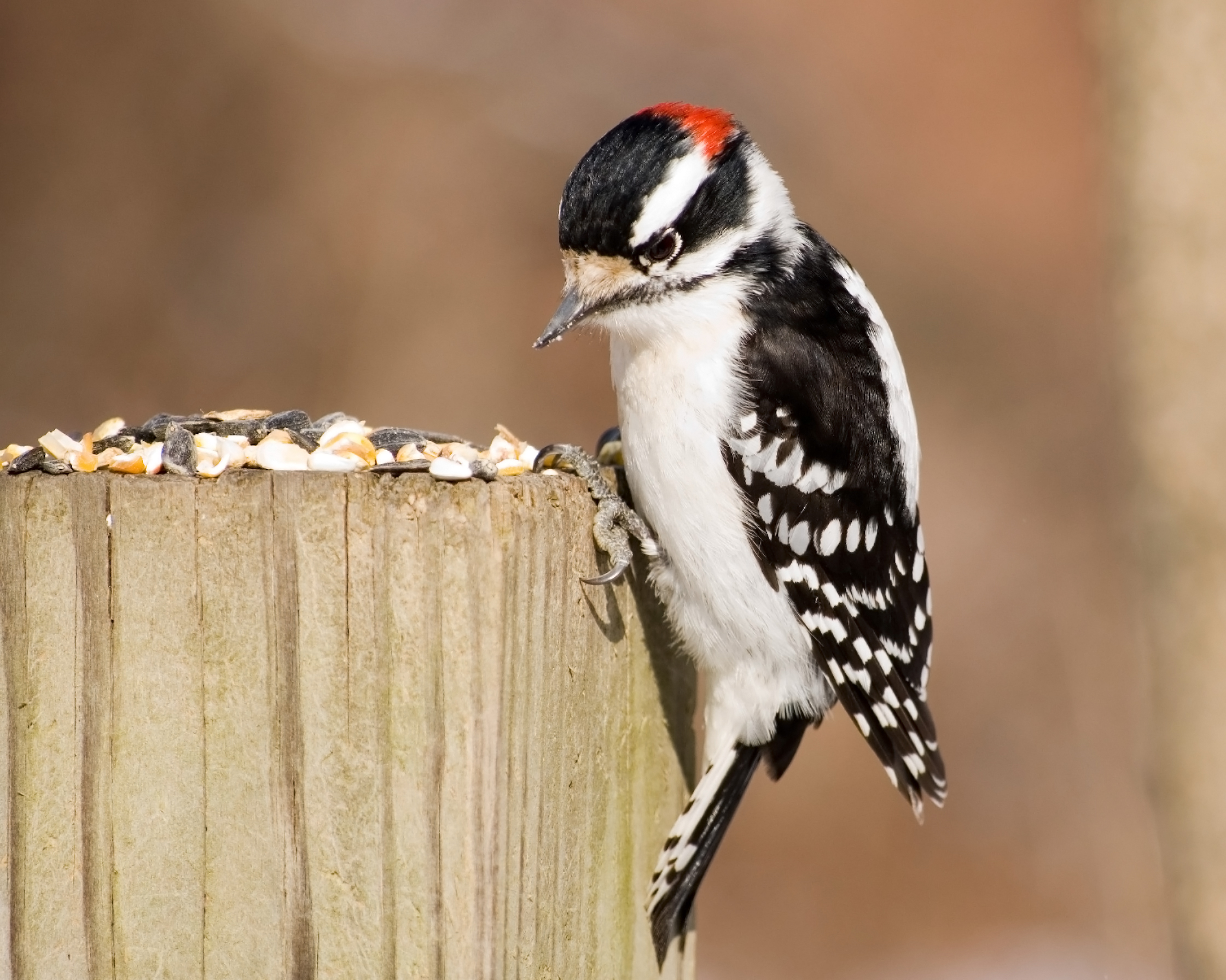 | Downy Woodpecker |
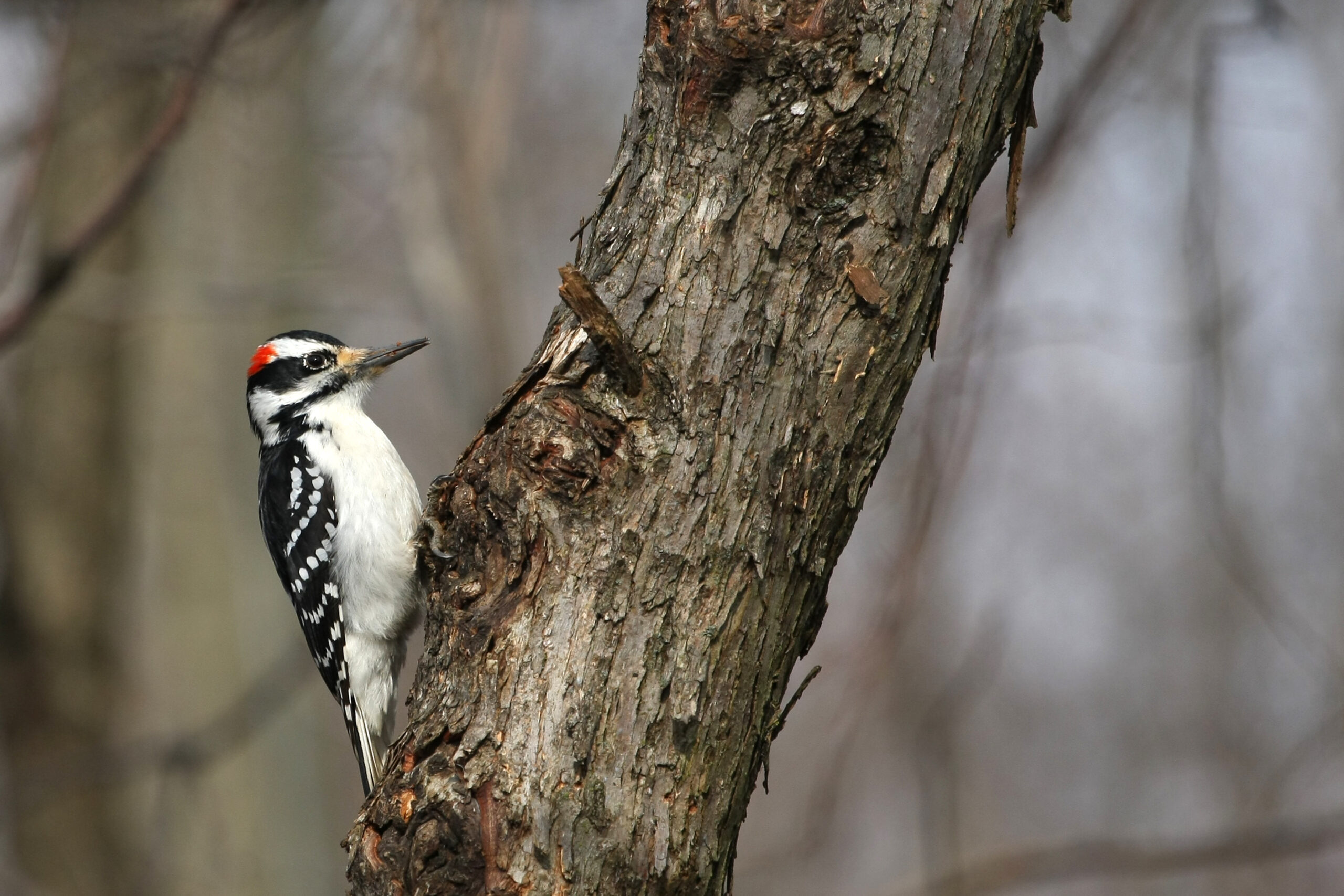 | Hairy Woodpecker |
 | Lewis's Woodpeckers |
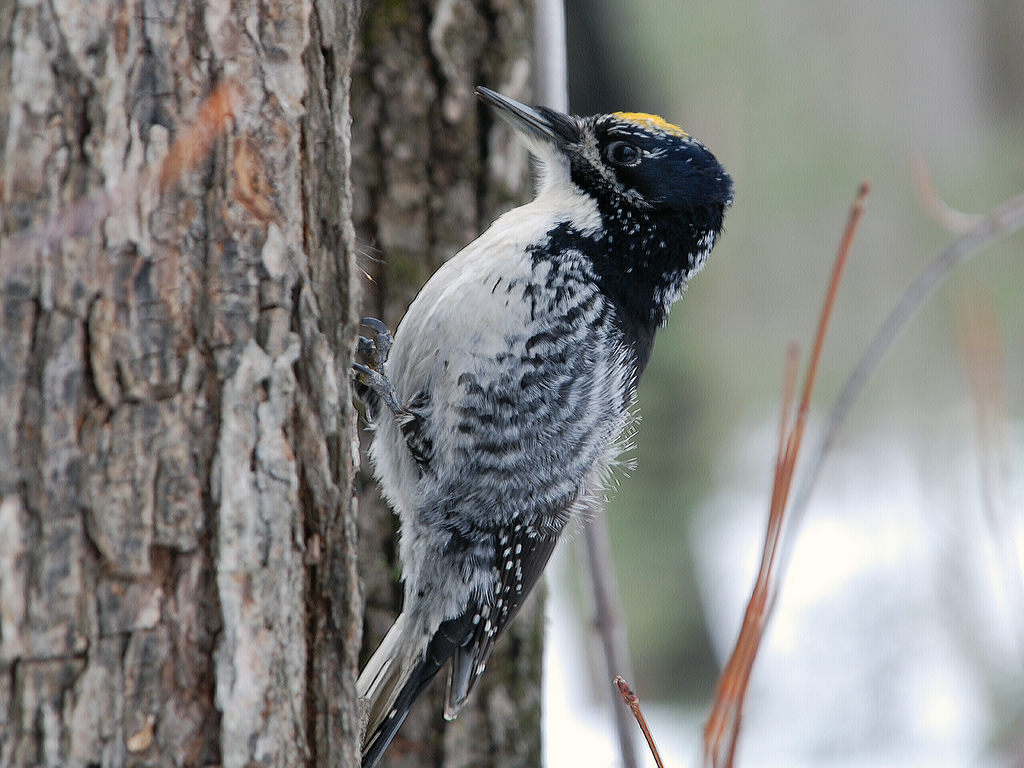 | Three-Toed Woodpecker of America |
 | Red Bellied Woodpecker |
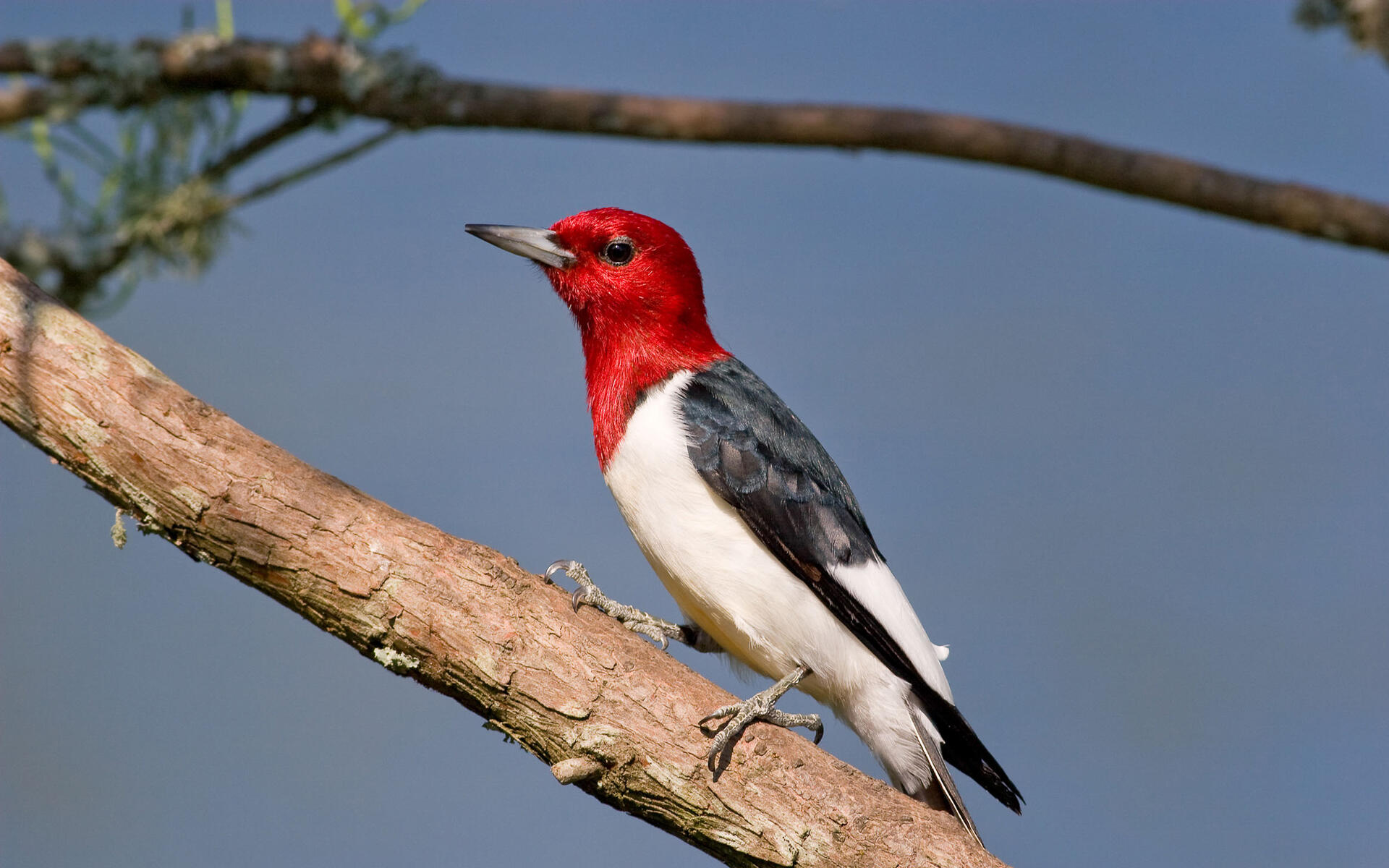 | Red-Headed Woodpecker |
 | Northern Flicker |
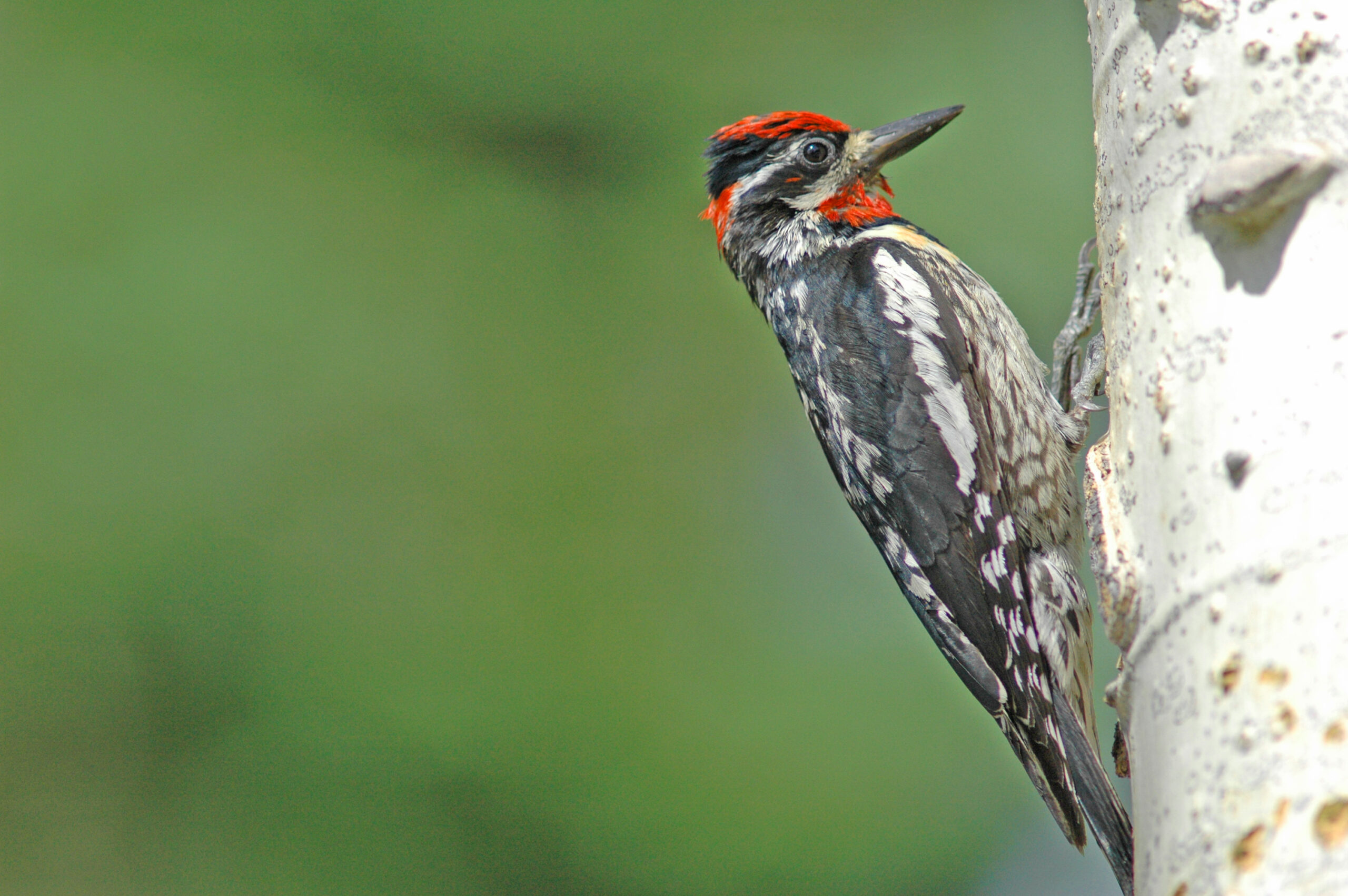 | Yellow-Bellied Sapsucker |
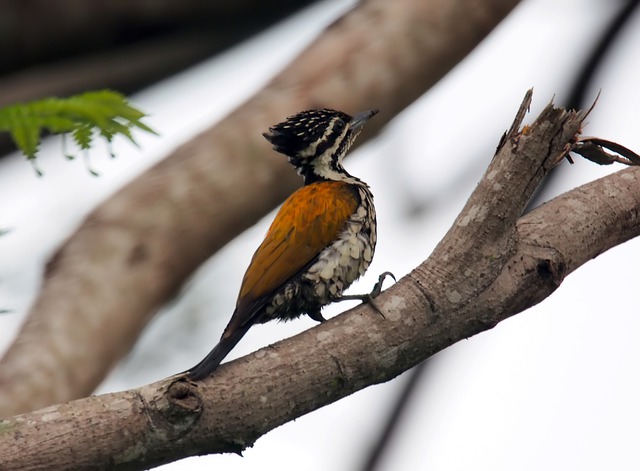 | Black-backed Woodpecker |
Types of Woodpeckers in Wisconsin
1. Pileated Woodpecker

The largest woodpecker in Wisconsin is the Pileated, which is a year-round resident of the state. The Pileated Woodpecker stands out dramatically thanks to its fiery-red triangular crest.
Given that it is almost as big as a crow, it is one of the largest woodpeckers. Its underside is white when it is flying, and it is primarily black with a white stripe.
On the cheek, males have an extra red stripe. Pileated Woodpeckers prefer dead trees as breeding locations.
Every year, they typically build a new nest, and other bird species use the previous one. Usually, they produce 3 – 5 white eggs.
Habitat & Food
They frequent backyard feeders specifically for the suet but are typically found in mature forests or woodlands that have been inundated and have a lot of dead trees.
Additionally, they consume suet, peanuts, black oil sunflower seeds, hulled sunflower seeds, mealworms, and peanuts.
In order to draw a breeding pair, you might also try erecting a nest box. Keep an eye out for these since they leave recognizable rectangular holes on trees.
2. Downy Woodpecker

In Wisconsin and all of North America, the Downy Woodpecker is the tiniest woodpecker. It is smaller than a hairy woodpecker having a smaller beak too.
The backs of the males’ heads are likewise covered with a crimson patch. Downy Woodpeckers lay three to eight tiny (0.8 in.) white eggs as their nests in dead tree cavities. These Woodpeckers are more likely to be seen at feeders.
Bird feeders in the backyard are frequented by Downy Woodpeckers. They are incredibly active and entertaining to watch, making a high-pitched pik sound and a falling whinny call.
Food
The main foods that downy woodpeckers consume are insects, particularly larvae and nuts, along with berries, acorns, and cereals. They can occasionally be spotted consuming liquids from hummingbird feeders.
Smaller woodpeckers like the Downy Woodpecker thrive on upside-down suet feeders because they provide shelter from the elements and deter aggressive birds. Suet cakes are more affordable when purchased in quantity.
3. Hairy Woodpecker
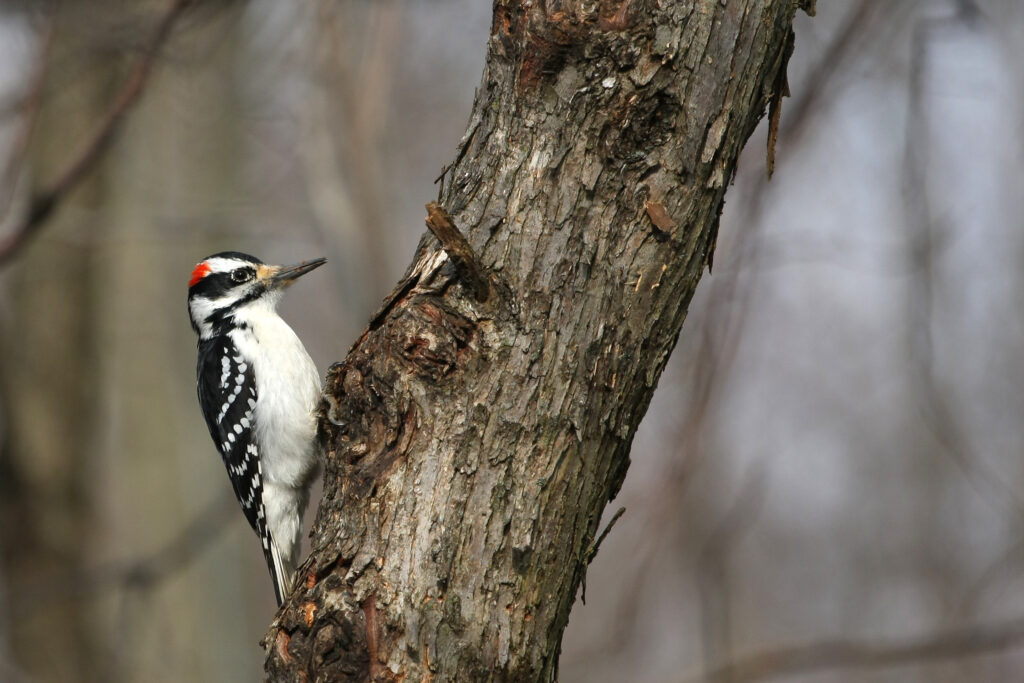
Hairy Woodpecker can be observed easily in wooded areas of Wisconsin. The rear of the heads of the males flashes red briefly. It resembles the Downy woodpecker in appearance but is bigger.
It is challenging to distinguish them because they are frequently found in the same places. They are strong little birds that can be spotted on backyard feeders and produce whinnying noises or loud peak yells.
Food & Habitat
Insects like beetle larvae, ants, and bark beetles make up the majority of the Hairy Woodpecker’s diet, but it also includes bees, caterpillars, spiders, moths pupae, and millipedes.
This woodpecker lays three to six white eggs in the hollow of dead trees or tree sections for its nests. Hairy Woodpeckers inhabit a variety of settings, including woodlots, parks, and cemeteries. Black oil sunflower seeds also draw more Hairy Woodpeckers to your yard.
4. Lewis’s Woodpeckers

Talking about the next woodpecker species, Lewis’s woodpecker is another species to be found in Wisconsin but pretty rare to be seen by human beings.
This bird hunts like a flycatcher, and it is very agile and fast and flies like a crow. Lewis’s Woodpeckers have a woodpecker-like bill with an extended body, tail, and wings.
To catch flying insects as they are in the air, they perch on poles, cables, and barren limbs.
Habitat
In open ponderosa pine, woodlands, orchards, agricultural areas with a few scattered trees, and burned forests are where you’ll often find them. Although they are not common in Wisconsin, winter is the greatest season to see them.
5. American Three-Toed Woodpecker

The American Three-Toed Woodpecker is a native woodpecker of North America. It has a white throat and belly, black and white sides, a blackhead, and black wings and rump. Adult males also have a yellow hat.
Occasionally, though infrequently, they can be seen near Lake Superior’s waters in upper Wisconsin throughout the year. The American Three-Toed Woodpecker consumes insect larvae, tree sap, fruit, Spruce Beetles, and other insects.
6. Red Bellied Woodpecker
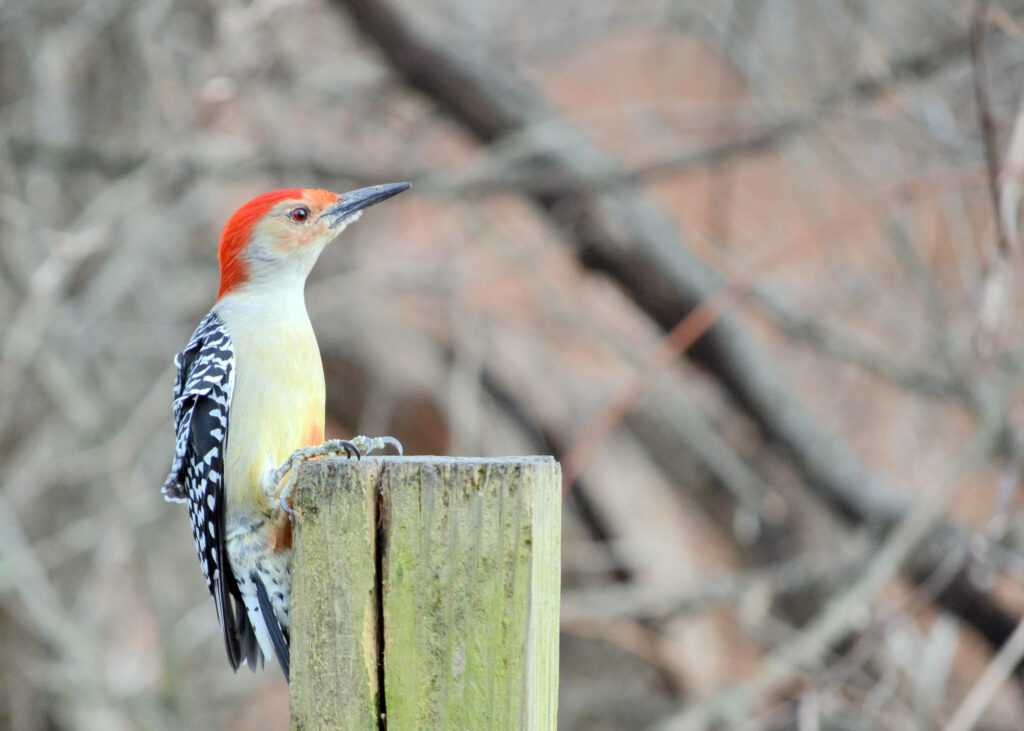
Red-bellied Woodpeckers are another common kind of woodpeckers that you will most likely see in Wisconsin. Particularly if you live close to wooded regions, these woodpeckers can frequently be spotted at bird feeders.
Due to their red napes and caps, male Red-bellied Woodpeckers can be confused for Red-headed Woodpeckers; however, they are much smaller.
Females lack red on the head but do have a red nape. Over their backs, they bear the typical black and white patterns.
Food
Insects, spiders, seeds from grasses, fruit, and nuts are all consumed by red-bellied woodpeckers. They will occasionally devour nestlings as well. They may reuse the same nest year after year and build their nests on dead trees.
The Red-bellied Woodpecker’s barbed tongue, which extends 2 inches past the beak and has a sticky spit tip, aids in catching prey from deep crevices.
In the eastern US, Red-bellied Woodpeckers are widespread in forests and woodlands, but they can also be found on bird feeders.
Red-bellied Woodpeckers will visit backyards in search of suet, so consider installing an upside-down suet feeder to deter squirrels and aggressive birds.
The bulk pack of these suet cakes is less expensive. Additionally, if you mix suet with black oil sunflower seeds in a fantastic suet and hopper feeder, you have two feeders in one. They will eat fruit and can also be observed on hummingbird feeders.
7. Red-Headed Woodpecker
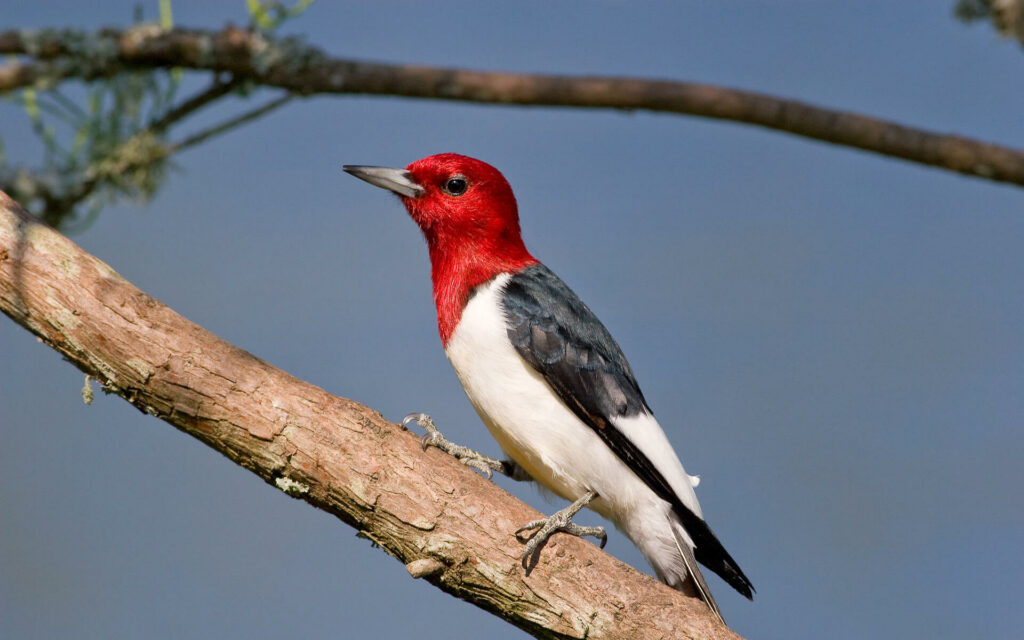
These woodpeckers are among the simplest to recognize due to their vivid redheads and distinct black and white patterns.
Medium-sized Red-headed Woodpeckers have strong spike bills. They have short tails, huge white stripes on the wings, black backs, and white undersides.
In Wisconsin, red-headed woodpeckers breed before heading south for the winter. They are more prevalent in Wisconsin’s southern regions.
They will aggressively defend their territory, even taking or destroying other birds’ or ducks’ eggs.
Food
Only around one-third of their diet is made up of insects, including grasshoppers, beetles, midges, and honeybees. The Red-headed Woodpecker will also steal eggs or nestlings from other birds and occasionally even from mice.
Red-headed Woodpeckers have a harsh call, lay four to five white eggs in tree cavities, sometimes utilizing the same location and nest there.
They can be discovered on farms, in open woodlots, in marshes with dead wood, or in pine savannas. They occasionally go to backyard bird feeders.
8. Northern Flicker

Northern Flickers breed in northern Wisconsin before moving south for the winter, though they can be seen there year-round. They are substantial brown woodpeckers with striking black spots on their feathers.
Habitat
Open forests, forest margins, parks, and suburbs are all good places to spot Northern Flickers. They frequently scavenge for food on the ground. A piercing shriek and a loud ringing call are produced by Northern Flickers.
With their curved bill, they frequently scrape up ants and beetles from the ground as well as eat fruits and seeds.
Your best chance is to install a beautiful pedestal birdbath or a heated birdbath for the winter because northern flickers visit birdbaths more frequently than they do bird feeders.
In order to draw a breeding pair, you can also grow berry-producing plants like grape, bayberries, hackberries, or elderberries, as well as erect a nest box designed for flickers.
9. Yellow-Bellied Sapsucker

Yellow-bellied Sapsuckers pierce holes in trees and extract sap using their tongues’ brush tips. They often only appear in the extreme south during migration.
Before making the long migration south for the winter, these sapsuckers reproduce more frequently in Wisconsin’s north.
It is comparable to a robin in size and is really small. The male has a red throat, and they are largely black with red foreheads. To keep the sap flowing, the holes must be kept clean.
They have 5 – 6 white eggs on average and have a loud mewing sound. They nest in tree cavities. Young deciduous woods frequently build orderly rows of sap wells to collect food on birch or maple trees.
10. Black-backed Woodpecker

Despite being rare, the Black-backed Woodpecker has been seen in Wisconsin’s northern counties. The range of the Black-backed Woodpeckers ends in Wisconsin.
As they are just robin-sized, they are difficult to identify, and their black backs help them blend in. On their flanks, they have black and white stripes, and most of their underbelly is white.
The male wears a yellow cap. It is particularly adept at consuming wood-boring beetle larvae in recently burned woodlands.
You have the highest chance of sighting the Black-backed Woodpecker in burned forests since it accomplishes this by flaking the bark off dead trees. They let out a single, precise pik call.
As opposed to the majority of species, which have four toes, this woodpecker has just three. With the exception of the absence of the white patch on their backs, they resemble the American Three-toed Woodpecker.
Black-backed Woodpeckers deposit three to four white eggs and create a fresh nest hole for each attempt at nesting, which is beneficial for other birds who depend on pre-made nest holes.
Conclusion
This discussion explains the different species of woodpeckers in Wisconsin. We have explained their various species and types, along with habitat and feeding habits. For more, see our blog.
FAQ
What is the largest woodpecker in Wisconsin?
The pileated, which is roughly the size of a crow, is the largest woodpecker in Wisconsin. Carpenter ants in trees with heartrot are primarily its winter meal, but it will occasionally also target a suet bag.
Can you find downy woodpeckers in Wisconsin?
Yes, In Wisconsin and all of North America, the Downy Woodpecker is the tiniest woodpecker. It is smaller in size than Hairy Woodpecker, and it also shares an identical appearance, but it possesses a smaller beak than any of the other kinds.
What distinguishes the downy woodpecker from the hairy woodpecker?
There are some significant differences that you may observe between a hairy and downy woodpecker. First, look for a significant bill size discrepancy.
The delicate beak of the Downy is roughly one-third the size of the bird’s head. In contrast, the Hairy’s bill is a railroad spike and is almost as long as its head.
Does Wisconsin have red-headed woodpeckers?
A medium-sized woodpecker with a vivid red hood and glossy black upperparts that juxtapose with a white body and wing patches is known as the Red-headed Woodpecker (Melanerpes erythrocephalus), a species that is listed as a Special Concern in Wisconsin.
Do Wisconsin have red-bellied woodpeckers?
The charismatic red-bellied woodpecker inhabits Wisconsin’s forests year-round and is a common sight. So you will see a lot of red-bellied woodpeckers in Wisconsin.
Last Updated on March 22, 2023 by Lily Aldrin
